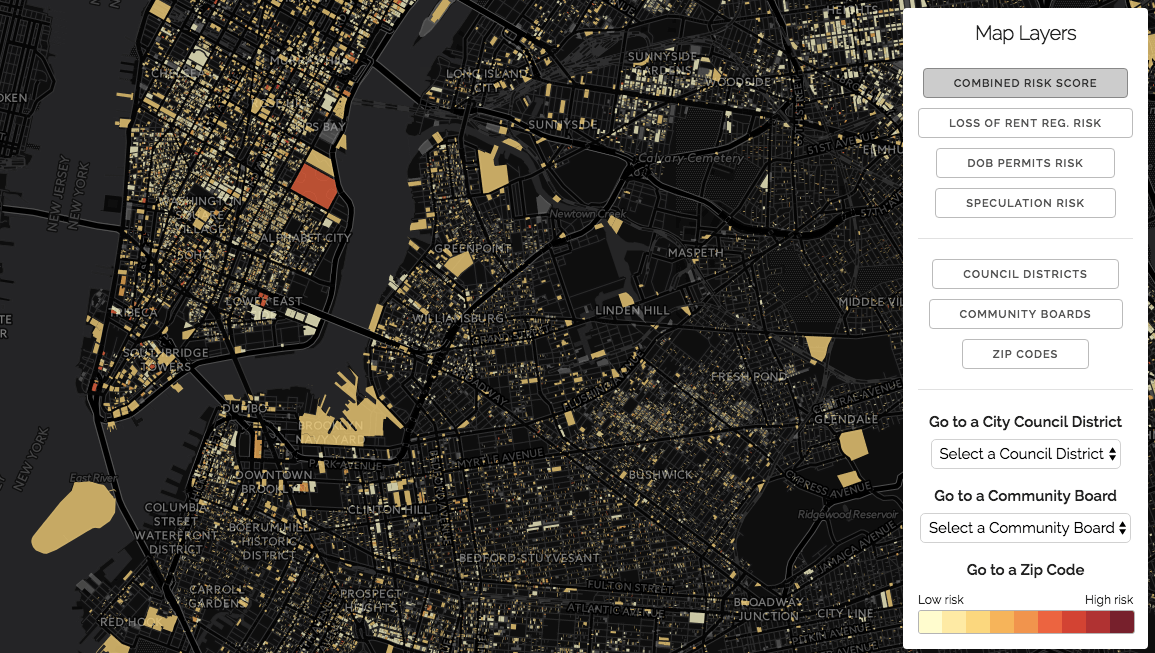
Policy Minute: Access to Counsel and Other Strategies to Prevent Displacement

Last week, the NYU Furman Center released a Policy Brief that examined the first year of implementation of New York City’s Universal Access to Counsel (UAC) program and identified lessons for other jurisdictions considering similar programs, such as San Francisco, Philadelphia, Los Angeles, Newark, Cleveland, and Boston. Enacted in August 2017, New York’s program is the first in the nation to provide legal representation for all income-eligible tenants facing eviction in housing court.
One of the major justifications for increasing access to legal representation is the concern that neighborhood changes such as gentrification may lead to increased tenant displacement. As New York City and other cities continue to grapple with displacement and fear of displacement, this Policy Minute rounds up some related recent developments and research.
Recently
- The New York City Office of Civil Justice released a report showing that nearly one third of tenants who appeared in housing court in 2017 had legal representation, compared to just 1% in 2013. Since calendar year 2017, residential evictions by City marshals declined by approximately 27% compared to calendar year 2013. Read the report.
- At a recent hearing of the Office of Civil Justice, legal services providers, advocates and other stakeholders provided perspectives on the first year of implementation of Universal Access to Counsel. Read the hearing transcript. Read the written statements submitted for the public hearing.
- Earlier this month, New York City Council members introduced a package of 18 bills aimed at preventing displacement and protecting tenants. Lawmakers, developers, and advocates weighed in on the proposals. Read the article.
- In September, Council members also introduced legislation to further expand access to legal representation for tenants facing eviction. The bill would expand access to counsel to all tenants at or below 400% of the federal poverty level, in any proceeding where ejection, eviction, or termination of residency may result. Read the legislation.
- Homeowner-landlords in the Bronx describe the challenges faced by small owners who are not able to afford legal representation in housing court and who file their own petitions to remove tenants for non-payment. Read the article.
NYU Furman Center Research and Resources
- Gentrification Responses: A Survey of Strategies to Maintain Neighborhood Economic Diversity reviews tools that local governments are experimenting with to address rising housing costs and displacement in gentrifying neighborhoods. The report examines several strategies to assist tenants at risk of displacement. Read the report.
- In the book, A Shared Future: Fostering Communities of Inclusion in an Era of Inequality, Faculty Director Vicki Been outlines a research agenda on displacement and gentrification, raising key research questions in four areas: Preservation of affordable housing; protection of tenants at-risk of displacement; inclusionary zoning; and revenue generation and incentives. The chapter makes a case for researchers and policymakers to consider the current gaps in knowledge about displacement, in order to develop informed policy responses. Read the chapter.
- Advancing Our Understanding of Gentrification, a Cityscape article by Faculty Director Ingrid Gould Ellen and Lei Ding of the Federal Reserve Bank of Philadelphia, describes recent trends in gentrification research and introduces a series of articles about the causes and consequences of gentrification and potential policy responses. Read the articles.
- On the interactive website LocalHousingSolutions.org, NYU Furman Center and Abt Associates summarize policy tools and resources that localities may consider to address displacement, improve housing stability and protect tenants. Visit the website.
Other Research and Reports
- Who Gets Evicted? by Matthew Desmond and Carl Gershenson, published in Social Science Research, describes disparities in housing displacement and demographic predictors of eviction, beyond missed rent payments. The study identifies individual, neighborhood, and network-level factors that are associated with eviction. Read the study.
- The Pepperdine Law Review article Do Lawyer’s Matter? by Emily S. Taylor Poppe and Jeffrey J. Rachlinski examines the existing empirical research on the impact of legal representation in civil disputes. The review demonstrates that legal representation is associated with more positive outcomes for litigants across a wide range of civil matters, including housing. Read the article.
Additional Viewpoints and Resources
- The Right to Counsel Coalition shares the organizing story of achieving right to counsel in New York City and offers organizing strategies and templates to assist organizers in other cities. View the toolkit.
- The National Coalition for a Civil Right to Counsel maps the status of right to counsel legislation and other policy developments in cities across the country. View the map.
- A Special Commission report on the Future of the New York City Housing Court makes recommendations to improve the housing court system as more tenants have access to counsel. The Commission recommends strategies to increase housing court legal and support staff, facilitate early assignment of counsel, and redesign housing court facilities. Read the report.
- A report commissioned by the Philadelphia Bar Association suggests that the benefits of providing legal representation to low-income tenants exceed the costs. Read the analysis.
- The Urban Institute recommends five strategies for addressing the national eviction crisis, beyond expanding legal representation to tenants. Read the article.
- The Association for Neighborhood & Housing Development (ANHD) Displacement Alert Project Map visualizes key displacement data to show where residential tenants may face displacement pressures across New York City. View the mapping tool.



